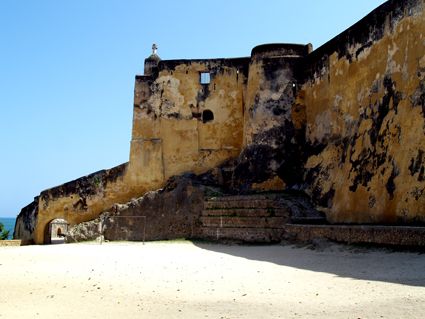Fort J
Fort Jesus is a Portuguese fort built in 1593 by order of King Philip I of
Portugal
(King Philip II of Spain),
then ruler of the joint Portuguese and Spanish Kingdoms,
located on Mombasa Island
to guard the Old Port of Mombasa, Kenya. It was built
in the shape of a man
(viewed from the air), and was given the name of Jesus. In
2011 the fort was declared
a World Heritage Site by UNESCO, highlighted
as one of the most
outstanding and well preserved examples of 16th century
Portuguese military fortifications
Between 1631 and 1875 the fort was won and lost nine times by the nations
contesting control of Mombasa. It was declared a historical monument in 1958.
Today it houses a museum.
The fort was designed by a Milanese architect,
Giovanni Battista Cairati, who was the Chief Architect for Portuguese
possessions in the East. It was the first European-style fort constructed
outside of Europe designed to resist cannon fire. Today, it is one of the
finest examples of 16th century Portuguese military architecture, which has
been influenced and changed by both the Omani Arabs and the British. The fort
quickly became a vital possession for anyone with the intention of controlling Mombasa
Island or the surrounding areas of trade. When the British colonised Kenya,
they used it as a prison, until 1958, when they converted it into a historical
monument. James Kirkman was then assigned to excavate the monument, which he
did (with a large use of external historical documents) from 1958 to 1971.
The architecture of the fort represents the rough outline of a person lying
on their back, with the head towards the sea. The height of the walls is 18 meters.
The original Portuguese fort had a height of 15 meters, but the much taller
Oman Arabs added 3 meters upon capturing the fort.
The fort combines Portuguese, Arab and British elements, representing the
major powers that held it at different times in history. Portuguese and British
presence if felt by the presence of their respective cannons. The Portuguese
cannons had a range of 200 meters and are longer than the British cannons which
had a range of 300 meters. Oman Arabs marked their occupancy with numerous
Koran inscriptions into the wooden door posts and ceiling beams. The Muslim
tradition of 5 pillars is also portrayed throughout the fort, with a former
meeting hall supported by 5 stone pillars to the ceiling.
Some of the historical structures still standing in the fort include Oman
House, which was the house for Sultan who governed the East African coast.
Others are an open water cistern by the Portuguese for harvesting rain water,
and a 76-foot deep well sank by the Arabs, but whose water was too salty to be
used for anything but washing.

